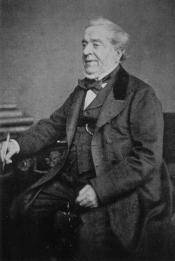William Banting (William Banting)

Author. He was an undertaker and furnisher of funerals, who had a parlour in St. James’s Street in London. His best-known commission was to build the Duke of Wellington’s coffin, but he would not be remembered were it not for the unfortunate fact that he suffered from a weight problem. None of his family, on either side, displayed any tendency to put on weight; but, from his thirties, Banting became increasingly large. He consulted a doctor, who instructed him to walk long distances and take up rowing, but this served only to increase his appetite and, therefore, put on more weight, to the extent that, in twenty years, Banting had to go into hospital twenty times in order to reduce his weight. He tried various starvation diets, took three Turkish baths a week, and drank “gallons of physic”, but lost only six pounds. By the time Banting reached his sixties, he weighed 14 stone 6 pounds (202 pounds), which may seem no great amount, even for a man who was only five foot six; but, as he wrote, “I could not stoop to tie my shoes, nor attend to the little offices which humanity requires, without considerable pain and difficulty.” He had to walk down the stairs backwards, to avoid putting weight on his ankles, and was plagued by an umbilical rupture, as well as increasing blindness and deafness. In August 1862, he consulted Dr. William Harvey, an ear, nose and throat specialist at the Royal College of Surgeons, about his loss of hearing. Dr. Harvey realised that this was caused by obesity, and advised Banting to give up bread, butter, milk, beer, sugar and potatoes, and live on a diet of meat and fish. By the end of the year, Banting could hear clearly again, had lost 42 pounds and 12 inches from his waist. Banting wrote about his experiences in a book entitled “A Letter on Corpulence, Addressed to the Public,” which appeared in 1863 and ran into several editions. Banting used the profits from this to endow the Middlesex County Convalescent Hospital at Walton-on-Thames. He has given his name to the verb “to bant,” meaning to diet, and this has passed into the German and Scandinavian languages, as well as English. The inscription reads: “In memory of Mary Ann, wife of William Banting of Kensington, who died October 21st. 1862, aged 62 years. Also of Amelia, daughter of the above, who died May 31st. 1864, aged 39 years. Also of William Banting, husband and father of the above, who died March 16th. 1878, in his 82nd. year.” (bio by: Iain MacFarlaine)
Born
- January, 01, 1970
Died
- March, 03, 1878
- England
Cemetery
- Brompton Cemetery
- England

